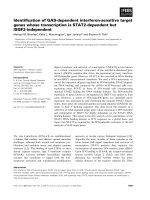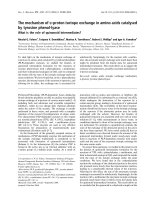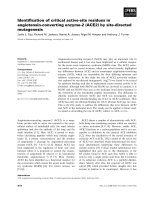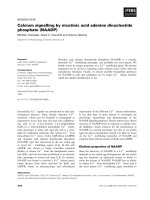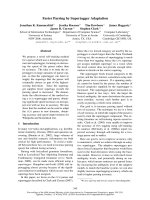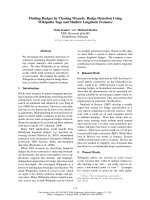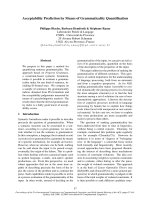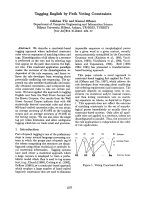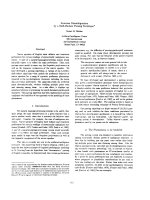báo cáo khoa học: "Chemoradiotherapy followed by surgery versus surgery alone in esophageal cancer patients: is it time for additional evidence?" doc
Bạn đang xem bản rút gọn của tài liệu. Xem và tải ngay bản đầy đủ của tài liệu tại đây (179.92 KB, 2 trang )
COR R E S P OND E N C E Open Access
Chemoradiotherapy followed by surgery versus
surgery alone in esophageal cancer patients: is it
time for additional evidence?
Stefano Cafarotti
1*
, Alfredo Cesario
1,2
, Venanzio Porziella
1
, Stefano Margaritora
1
and Pierluigi Granone
1
Abstract
Recent efforts to improve survival in patients with locally advanced esop hageal carcinoma have combined both
systemic and local therapy. However, the role of neoadjuvant chemoradiotherapy in technically operable IIa-III
esophageal carcinoma is still unresolved.
Findings
We have read with interest the report from Hurmuzlu
and coll [1] on the outcome of induction therapy (IT)
plus surgery versus surgery alone in locally advanced
operable esophageal cancer (OC).
The report is of great speculative interest given the
consistently poor prognosis of OC whatever the thera-
peutic strategy adopted: so far, in fact, there is no ge n-
eral consensus on the appropriate treatment for such a
dreadful condition. Specifica lly, the role of chemo-radio-
therapy administered pre-operatively in resectable cstage
IIa-III OC is still discussed.
Scarce data are available from the literature and these
are not consistent. In f act some experiences [2,3] con-
clude with positive recommendations to adopt the tri-
modality approach and others [4] conclude with oppo-
site positio n: that IT should not be adopt ed in OC that
areresectablefollowingtheclinical staging assessment.
As already advocated by Perei ra [5], the indicat ion for
IT for resectable OC remains largely not evidence-based
substantially due to methodological biases in the trials
that can be summarised as follows: different tumour
stages included, no standardized preoperative diagno stic
procedure and, last but not least, the great heterogenity
of surgical treatment.
In this scenario of substantial absence of a large base of
methodologically correct evidence and agreed guidelines
we consider the results from [1] of significant clinical
value and concur in advocating for further evidence
stemming from large scale prospective randomised trials.
Ideally, these should be designed valuing the past experi-
ences to address the methodological biases with the pre-
cise task to assess whether IT should be administered
before surgery in resectable OC. These trials should: a)
distinguish between hystologies (squamous cell vs adeno-
carcinoma); b) include an optimal pre-operative staging
with EUS, high quality CT a nd PET scan to assess the
extent of the loco-regional disease and exclude distant
metastases and c) include a standardized surgical treat-
ment with extended lymph node dissection. Only by such
trials the role of IT in the treatment of OC can be
cleared. More convincing arguments, in fact, need to sup-
port any proposed change in clinical behaviour.
Author details
1
Division of General Thoracic Surgery, Catholic University, Rome, Italy.
2
Unit
of Clinical and Molecular Epidemiology, IRCCS San Raffaele Pisana, Rome,
Italy.
Authors’ contributions
All authors read and approved the final manuscript.
Competing interests
The authors declare no conflicts of interest
Received: 22 January 2011 Accepted: 19 April 2011
Published: 19 April 2011
References
1. Hurmuzlu M, Øvrebø K, Monge OR, Smaaland R, Wentzel-Larsen T, Viste A:
High-dose chemoradiotherapy followed by surgery versus surgery alone
in esophageal cancer: a retrospective cohort study. World J Surg Oncol
2010, 8:46.
* Correspondence:
1
Division of General Thoracic Surgery, Catholic University, Rome, Italy
Full list of author information is available at the end of the article
Cafarotti et al. World Journal of Surgical Oncology 2011, 9:41
/>WORLD JOURNAL OF
SURGICAL ONCOLOGY
© 2011 Cafarotti et al; licensee BioMed Central Ltd. This is an Open Access article distribute d under the terms of the Creative
Commons Attribution License ( which permits unrestricted use, distribution, and
reprodu ction in any medium, provided the origi nal work is properly cited.
2. Tepper J, Krasna MJ, Niedzwiecki D, Hollis D, Reed CE, Goldberg R, Kiel K,
Willett C, Sugarbaker D, Mayer R: Phase III trial of trimodality therapy with
cisplatin, fluorouracil, radiotherapy, and surgery compared with surgery
alone for esophageal cancer: CALGB 9781. J Clin Oncol 2008,
26(7):1086-92.
3. Knox JJ, Wong R, Visbal AL, Horgan AM, Guindi M, Hornby J, Xu W,
Ringash J, Keshavjee S, Chen E, Haider M, Darling G: Phase 2 trial of
preoperative irinotecan plus cisplatin and conformal radiotherapy,
followed by surgery for esophageal cancer. Cancer 2010, 116(17):4023-32.
4. Burmeister BH, Smithers BM, Gebski V, Fitzgerald L, Simes RJ, Devitt P,
Ackland S, Gotley DC, Joseph D, Millar J, North J, Walpole ET, Denham JW,
Trans-Tasman Radiation Oncology Group; Australasian Gastro-Intestinal Trials
Group: Surgery alone versus chemoradiotherapy followed by surgery for
resectable cancer of the oesophagus: a randomised controlled phase III
trial. Lancet Oncol 2005, 6:659-668.
5. Pereira B, Gourgou-Bourgade S, Azria D, Ychou M: Neoadjuvant
chemoradiotherapy in esophageal cancer: is it still the question? J Clin
Oncol 2008, 26(31):5133-4, author reply 5134.
doi:10.1186/1477-7819-9-41
Cite this article as: Cafarotti et al.: Chemoradiotherapy followed by
surgery versus surgery alone in esophageal cancer patients: is it time
for additional evidence? World Journal of Surgical Oncology 2011 9:41.
Submit your next manuscript to BioMed Central
and take full advantage of:
• Convenient online submission
• Thorough peer review
• No space constraints or color figure charges
• Immediate publication on acceptance
• Inclusion in PubMed, CAS, Scopus and Google Scholar
• Research which is freely available for redistribution
Submit your manuscript at
www.biomedcentral.com/submit
Cafarotti et al. World Journal of Surgical Oncology 2011, 9:41
/>Page 2 of 2

